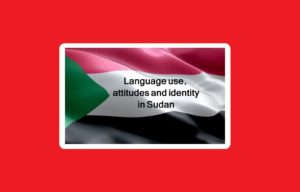Language use, attitudes and identity in Sudan Conclusions from sociolinguistic surveys in Darfur and Khartoum
This paper discusses language use, attitudes and identity among non-Arabic speaking communities in Sudan, based upon sociolinguistic surveys in Darfur and Khartoum. The first survey, that will be concluded in this paper, was conducted among speakers of the Tagoi language in Khartoum.

This Kordofanian language, belonging to the Niger-Congo language phylum, is originally spoken in the eastern Nuba Mountains (Quint 2006:2). It was estimated to be spoken by about 13,000 people in 1982 (Lewis et al 2014). In March 2012 a sociolinguistic survey was conducted among 551 speakers of Tagoi in Omdurman and Khartoum. The survey was part of the Tagoi language documentation project, funded by the Endangered Languages Documentation Programme, SOAS, London, and carried out by the Department of Linguistics, University of Khartoum. This paper concludes that Tagoi is rarely spoken at home and that there is a lack of intergenerational transmission among the Tagoi respondents in Omdurman and Khartoum. The negative opinions of many of the respondents about the future vitality of the Tagoi language and the unstable security situation in the original homeland of the Tagoi people also point to a high level of endangerment of the language.
The second survey, accounted for in this paper, was conducted in 2013 among 150 Midob speakers in the original area of the language, i.e. the North Darfur state in western Sudan. Midob is a Nubian language, related to the other Darfur Nubian language, Birgid, and the Nile Nubian and Kordofan Nubian languages of the Nilo-Saharan language family (Thelwall 1983). It is estimated to be spoken by 50,000 people by Werner (1993) and Lewis et al (2014). There is a strong wish among the Midob people to maintain their language and create an orthography. The main aim of this sociolinguistic survey was to find out which of the two main dialects, Uurti and Kaargedi, the respondents would prefer to be the basis for the written language, but the survey also included questions on language use and attitudes.
This paper will present data of language use and attitudes from these two surveys. The data will be cross-referenced with demographic information about the respondents, such as gender, age, level of education, profession, place of birth, present place of residence and migration, in order to understand the relationship between language use and attitudes and these variables. The question of language and identity, based upon interviews with speakers, will also be discussed.
Dr. Helene Fatima Idris[1]
[1] Department of Linguistics, University of Khartoum
الترجمة
استخدام اللغة والمواقف والهوية في السودان استنتاجات من المسوحات اللغوية الاجتماعية في دارفور والخرطوم
تناقش هذه الورقة استخدام اللغة والمواقف والهوية بين المجتمعات غير الناطقة بالعربية في السودان ، بناءً على مسوحات اجتماعية لغوية في دارفور والخرطوم. الاستطلاع الأول الذي سينتهي في هذه الورقة تم إجراؤه بين المتحدثين بلغة تاجوي في الخرطوم. تنتمي هذه اللغة الكردفانية إلى لغة النيجر والكونغو ، ويتم التحدث بها في الأصل في جبال النوبة الشرقية (Quint 2006: 2). قُدِّر أن يتحدث بها حوالي 13000 شخص في عام 1982 (لويس وآخرون 2014). في مارس 2012 تم إجراء مسح اجتماعي لغوي بين 551 متحدثًا بلغة التاجوي في أم درمان والخرطوم. كان المسح جزءًا من مشروع توثيق لغة تاجوي ، الممول من برنامج توثيق اللغات المهددة بالانقراض ، SOAS ، لندن ، ونفذه قسم اللغويات بجامعة الخرطوم. تخلص هذه الورقة إلى أنه نادرًا ما يتم التحدث بالتاجوي في المنزل وأن هناك نقصًا في الانتقال بين الأجيال بين المستجيبين للتاجوي في أم درمان والخرطوم. تشير الآراء السلبية للعديد من المستجيبين حول الحيوية المستقبلية للغة تاجوي والوضع الأمني غير المستقر في الموطن الأصلي لشعب تاجوي أيضًا إلى مستوى عالٍ من تعريض اللغة للخطر. المسح الثاني ، الوارد في هذه الورقة ، تم إجراؤه في عام 2013 بين 150 متحدثًا ميدوبًا في المنطقة الأصلية للغة ، أي ولاية شمال دارفور في غرب السودان. ميدوب هي لغة نوبية ، ترتبط بلغة دارفور النوبية الأخرى ، البرقد ، واللغات النوبية النوبية وكردفان من عائلة اللغات النيلية الصحراوية (Thelwall 1983). يقدر أن يتحدث بها 50000 شخص بواسطة Werner (1993) و Lewis et al (2014). هناك رغبة قوية بين أفراد Midob للحفاظ على لغتهم وإنشاء قواعد إملائية. كان الهدف الرئيسي من هذا الاستطلاع اللغوي الاجتماعي هو معرفة أي من اللهجتين الرئيسيتين ، أورتي وكارجي ، يفضل المستجيبون أن يكونوا أساس اللغة المكتوبة ، لكن الاستطلاع شمل أيضًا أسئلة حول استخدام اللغة والمواقف. ستعرض هذه الورقة بيانات استخدام اللغة والمواقف من هذين الاستبيانين. سيتم مقارنة البيانات مع المعلومات الديموغرافية حول المستجيبين ، مثل الجنس والعمر ومستوى التعليم والمهنة ومكان الميلاد ومكان الإقامة الحالي والهجرة ، من أجل فهم العلاقة بين استخدام اللغة والمواقف وهذه المتغيرات. كما ستتم مناقشة مسألة اللغة والهوية ، بناءً على مقابلات مع المتحدثين.
